Items tagged with 'Capital Region'
Capital Region economic development grants: residential conversions, sewers, Lincoln Park pool, Urban Grow Center
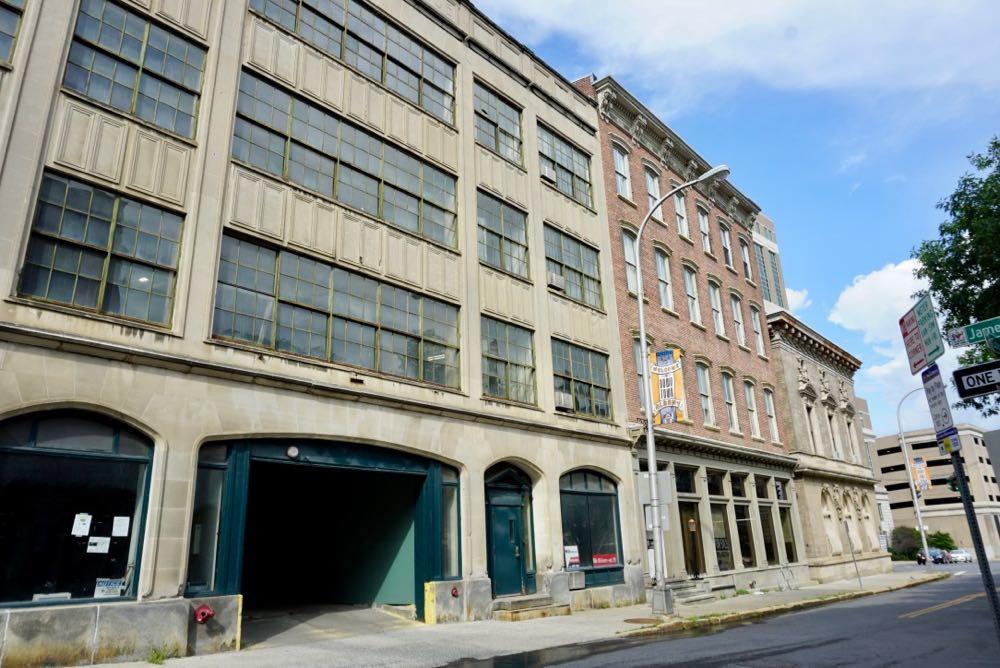
The residential conversion of the Kennedy Garage in downtown Albany is line for a $1 million grant.
The Capital Region scored $67 million in the state's annual Region Economic Development Council awards/game show/porktacular on Tuesday.
The region was not a "top performer" this year -- the awards roughly broke out into $80some million and $60some million tiers this time around. (The Capital Region had been in the higher tier the last two years.)
Here are details on the specific projects getting funding in the Capital Region are below, along with a bunch of that caught our eye. There are also region-by-region totals for the awards.
Albany winters have been getting warmer
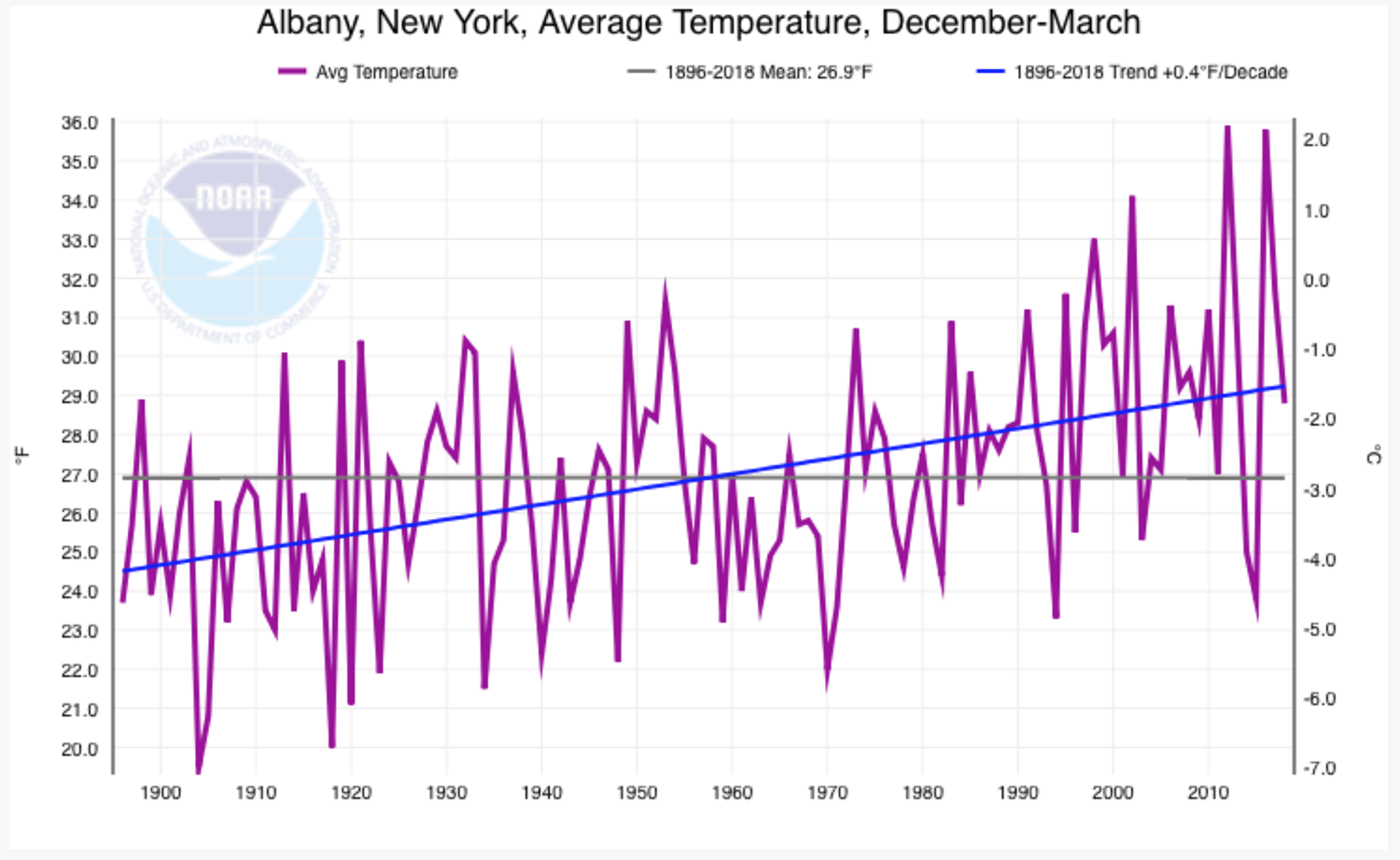
Here's a larger version.
A lot of people seemed to enjoy last week's post about when it's "actually" winter here -- that is, the part of the year here that tends to have the coldest temperatures rather than the standard definitions of the season. We looked at it two ways, and the best way (in our opinion) pegged winter in the Albany area as being from December 1 to March 20.
So here's the B side to that track: On average, winters in the Albany area have been getting warmer over the last century (plus). And not by a little -- the average December-March temperature here has been trending up by .4 degrees Fahrenheit per decade.*
That graph above was generated by an interactive tool on the website for NOAA, the federal agency. It shows the trend for average December-March temperatures in Albany between 1896 and 2018.
Here are a few more bits.
Here's when the seasons really start and end in the Albany area*
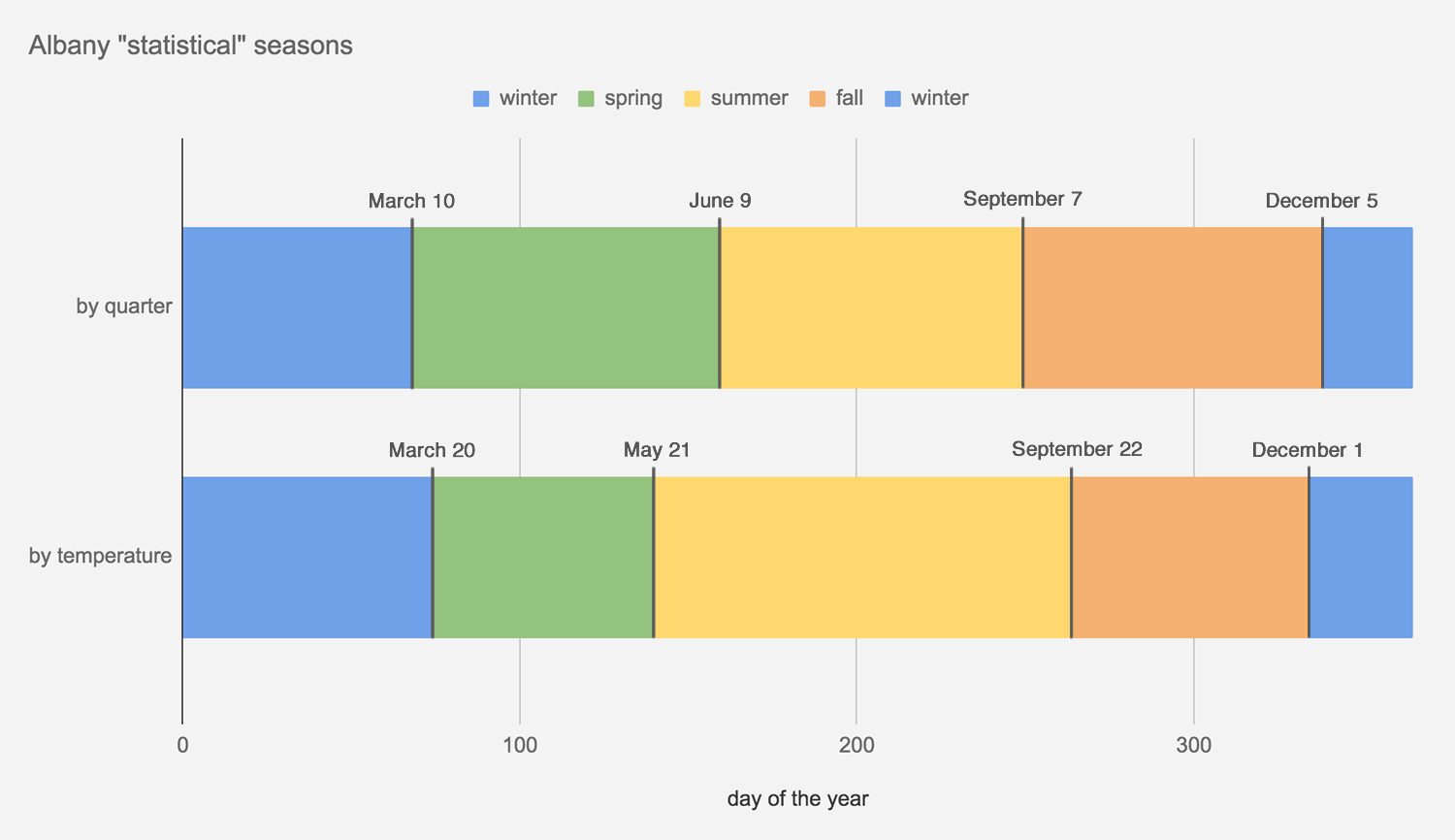
* On average. And by these definitions, which are just one or two ways of looking at this topic. Really, it's winter whenever you decide to switch to the big coat and put the shovel in the car. | Also: Here's a larger, easier-to-read version of this graph.
Winter starts December 21 -- by the astronomical definition. And it starts December 1 by -- the meteorological definition.
But when does it really start in Albany?
Inspired by a chart and discussion on Twitter today attempting to mark the start of seasons in various places around the country based on normal temperatures, we figured it'd be interesting to look at the daily temperatures in Albany in order to define what you might call the "statistical" seasons. That is, when the seasons start based on what the temperatures actually are and not what the calendar says.
Of course, you can interpret numbers all sorts of ways. And in this case we ended up doing it two ways:
+ Breaking the year up into (roughly) four quarters according to normal temperatures. Winter's the coldest 25 percent of the days each year, summer's the warmest 25 percent, and spring and fall are what's in between. Looking at it this way, winter starts December 5 and lasts until March 10.
+ Looking at the distribution of temperatures here throughout the year and defining winter and summer as the days when temperatures are either in the bottom or top 25 percent of the distribution. Spring and fall are everything in between. Looking at it this way, winter starts December 1 and lasts until March 20.
And: See resulting chartage above. Don't worry, we've included a larger version here, along with a bonus graph.
Here's a bit more explanation and weather nerding...
Friend connections across space and time

This is just a screengrab. If you head over to The Upshot, there's an interesting interactive map with sorts of info.
Over at the New York Times, The Upshot has an interesting interactive look at some research into Facebook friend links by place. Basically, the team of researchers tried to figure out how closely counties are connected by these social ties:
The darker the color, the greater the relative likelihood that any two people living in two different counties are connected on Facebook. Counties that are broadly tied to more -- and more distant -- places will color in more of the map. Counties where nearly all ties are very local will look more isolated.
That's a clip of the interactive map above selected for Albany County. A couple quick things that we noticed:
+ It's notable how East Coast-heavy the connections are for the Capital Region core counties -- not just eastern United States, but the actual coastal area. (Though Saratoga County's connections are a bit more widespread nationally.)
+ Maybe you noticed those two counties in Mississippi that stick out as having a relatively high number of connections to Albany County? They're Wayne County and Clarke County. And if you click on Clarke County in the NYT's interactive, Albany County pops up as a highly-connected place for it. The reason, we suspect, is history: Shubuta, Mississippi is in Clarke County. And it was from the Shubuta area that many families made their way from Mississippi to Albany during the Great Migration, first settling in the South End, with some families later moving to the Pine Bush.
There's a whole lot more at The Upshot about some of the patterns that emerged in the research about the effect of things like state lines. And there's even some new fuel for the ongoing "Where is Upstate?" discussion.
Mapping out the future for an alternative transportation network in the Capital District
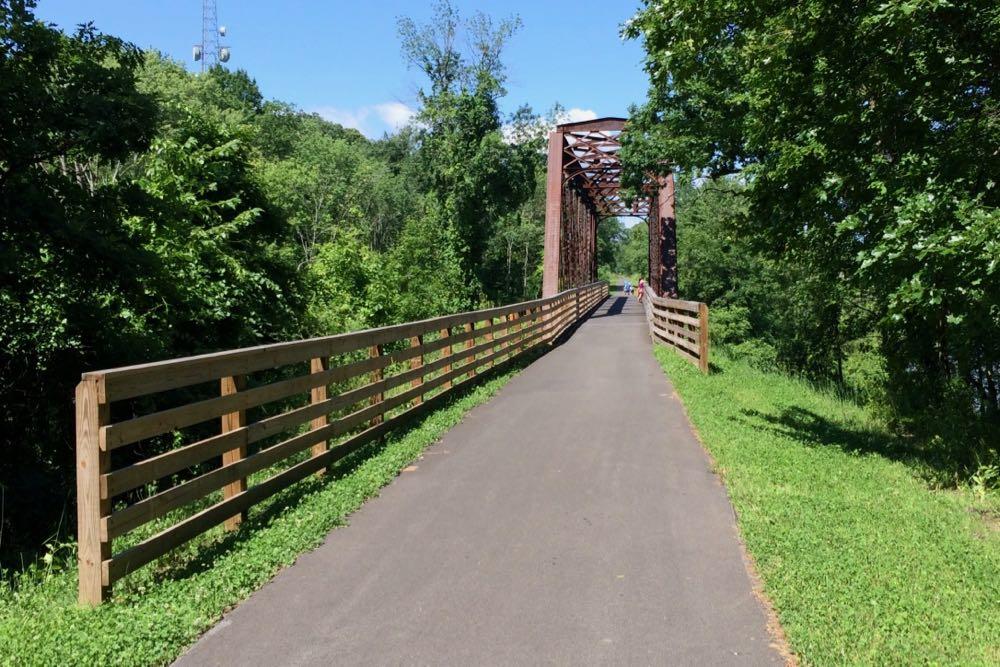
The Capital Region already has a handful of popular biking and walking trails, but if you zoom out a little bit and look at the whole picture you can the see the outline of something a lot bigger.
That something is what Jennifer Ceponis, a senior transportation planner for the Capital District Transportation Committee, describes as an alternative transportation network: "Much like we have a highway system for cars -- with supporting roads and arterials that feed into that -- we want people to be thinking that the region can have a similar system but for bicycling, walking, and other recreational activities."
Toward that goal, the planning org has put together the Capital District Trails Plan, a map toward a future in which you might be able to ride a bike from, say, Voorheesville to Saratoga Springs and beyond on a network of paths.
Here are a few highlights.
Where the Capital Region's younger adults live

Maybe you saw that new list this week that ranked a ZIP code in Guilderland as the "best" neighborhood in Upstate New York for young adults.
The ranking was the result of some crunching by Buffalo Business First of Census numbers related to population, education, employment, businesses, housing, and income. That link includes an explanation of the methodology.
That a ZIP code in Guilderland would take the top spot in this sort of ranking raised some eyebrows. And we'd argue the list's methodology is basically a way of filtering for upper income people in their 20s and 30s.
Also: "Best" for whom? People in their 20s and 30s are a huge, diverse population group. Using a word like best is probably an overreach.
Anyway, the list got us curious about neighborhoods in the Capital Region that do have a lot of people 40 and under. So we rolled together some of our own clickable maps...
A pro soccer team for the Capital Region? Sure, in some form, why not?

FC Cincinnati -- and its big fanbase -- is making the jump from USL to MLS next season. / photo: Flickr user Hayden Schiff (CC BY 2.0)
Every now and then we see the idea of the Albany area getting a pro soccer team pop up during a discussion.
And, yeah, that could be a lot of fun.
Of course, when most people think "pro soccer" for the United States, they think MLS. And that... well, that's not going to happen in the Capital Region anytime soon (if ever).
Here's why, along with some other options for pro soccer that look a lot more likely.
How the Albany metro area compares favorably to places such as Boston, DC, and Austin
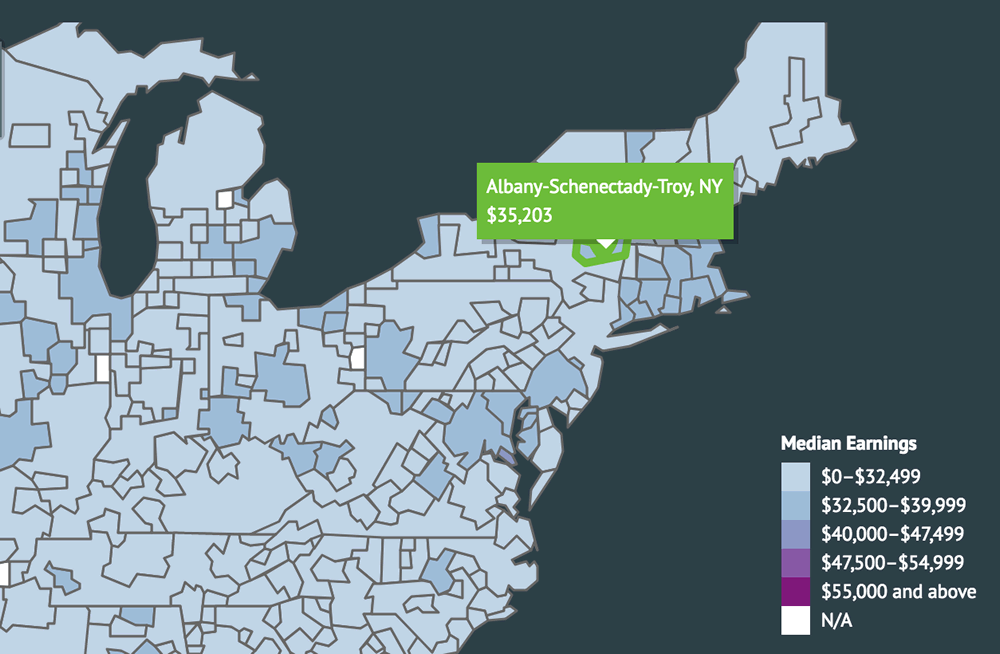
This is a screengrab from the Hamilton Project interactive visualization.
We were having a conversation the other day with someone about some of the things people who don't live here -- especially people from larger metros -- might not understand or appreciate about the quality of life here.
And one thing that immediately sprang to mind: There are (relatively) good job opportunities in the Albany metro area, and the (relatively) low cost of living means you can live here (relatively) comfortably without having to scrape like you would in a lot of big/coastal metros.*
That point is illustrated by this interesting interactive data visualization from The Hamilton Project at Brookings -- it depicts median income by occupation and age across the nation's 300some metro areas. (It's attached to an analysis aptly titled "Where Work Pays: How Does Where You Live Matter for Your Earnings?")
And here's the important thing: it gives you the option to adjust for cost of living and taxes.
So how's that work out for Albany?
Here are the most popular drop-off spots for Uber and Lyft in this area

A popular spot for both Uber and Lyft.
It's now been a year since ride-hailing services such as Uber and Lyft have been allowed to operate across New York State.
And this week the two companies shared lists of their most popular drop-off destinations in the Capital Region.
Let's have a look.
The Capital Region's home ownership rate ticked upward last year for the first time in a while

The Capital Region's home ownership's most recent peak was in 2010. It ticked up for the first time since then in 2017. Do note that the scale for the rate starts at 50. There's a chart with a from-0 scale inside. / data via US Census Bureau
Another few bits for the apartments / rents discussion...
The home ownership rate in the Albany-Schenectady-Troy metro area ticked upward for the first time since 2010 last year.
The Albany metro's rate was 64.1 percent, according to the Census Bureau. That was up from 61.3 the year before.
That's interesting, in part, because there's evidence that the upswing in rents in the Capital Region also flattened out last year. Maybe it's a matter of demographics as the population peak of Millenials grows older. Maybe rents have just risen to a point where it makes more financial sense to buy a house. (As with any complicated topic, it's probably some of those things and a bunch of other stuff, too.)
Anyway, you know that we have an additional chartage, because of course...
All the Capital Region's sidewalks

We enjoy both maps and sidewalks.
So, not surprisingly, we were interested in this new map of all the sidewalks in the Capital Region. That's some 1,225 miles of sidewalk.
The map is the the product of three years of work by the Capital Region Transportation Committee. It was created primarily for compliance work for the Americans with Disabilities Act, and also to assist with planning for pedestrian infrastructure.
Also: It's a map of all the sidewalks.
Here's the full map and a few bits...
Maybe all those new apartments are starting to have some effect on rents
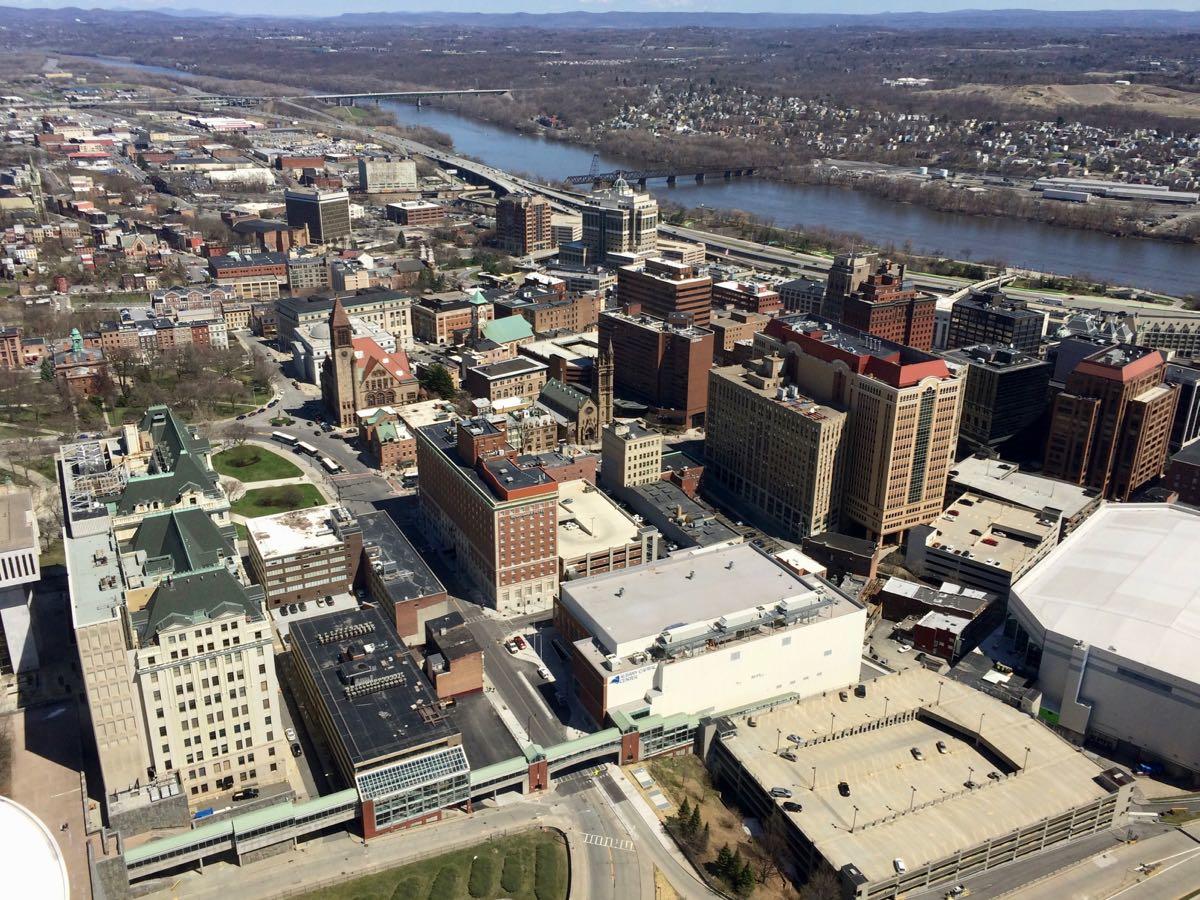
Downtown Albany has been hot spot for new apartments in recent years.
A sort-of follow-up to the recent post about all the apartments the Capital Region has been adding the last few years (with many more in the pipeline)...
Capital Region rents have been on an upswing during the past half decade, but that increase appears to have flattened during the last year. That's one of the bits from the new Capital Region multi-family market report published by Sunrise Management & Consulting.
Sunrise president Jesse Holland in a press release: "The data indicates that the market is getting saturated ... Everyone wants to know if the time to build more apartments is over, or if the economy is going to take off."
A chart (because of course) and a few more interesting bits from the report...
Apartments, apartments, and more apartments
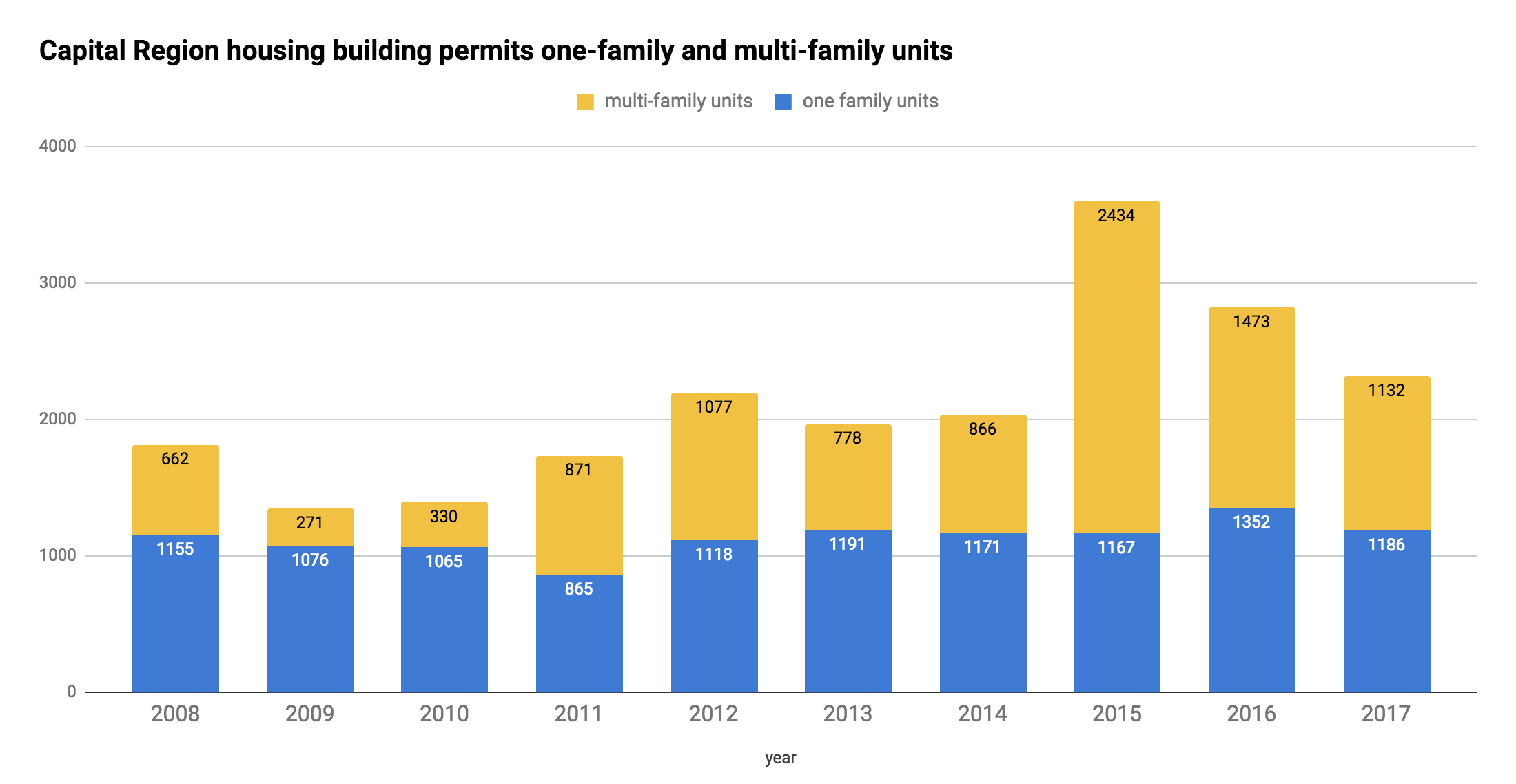
Capital Region building permits for residential units over the last decade -- for single family homes and units in multi-family buildings.
Sometimes during episodes of Exciting Tales of the Albany Planning Board and related whatnot, we refer to the apartment building boomlet that's been going in Albany and around the Capital Region.
Right, so about the specifics of that boomlet... The Census Bureau collects data on the number of building permits for housing units issued each year in each municipality. And those numbers help draw the outline of this trend.
For example: The chart above shows the number of overall units covered by building permits issued for the four core Capital Region counties over the last decade -- along with how many of those units were in multi-family buildings (yellow). And as you can see, there's been an upswing in multi-family units in that time, especially the last few years.
More context? More details? OK, let's have a look...
Must-do Albany/Troy activities for new arrivals to the Capital Region?

Lindsay emails:
Some long-time friends of mine will be moving to the Capital Region in June, and I was looking for some expert/crowd-sourced advice on must-do Albany/Troy/etc activities for Capitol Region neophytes, anywhere from the mundane-- signing up for Price Chopper rewards cards-- to fun things, like attending a concert at SPAC.
We know there are more than a few people in the AOA crowd have moved to this area from somewhere else. And we're guessing you might have some good ideas. On the flip side, if you've lived here all your life, we bet you might have a few things in mind that someone would now only only from maybe living here most of their life.
So, got a suggestion for Linday's friends? Please share! And a sentence or two explaining your suggestion can be helpful.
Earlier on AOA: You're New Here
Amazon Town
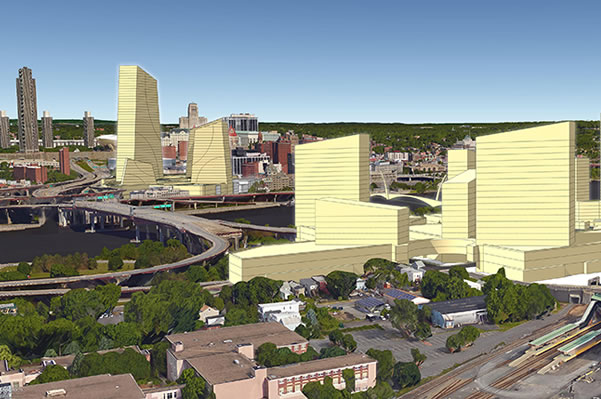
One of the renderings from the Capital Region's Amazon HQ2 bid.
You might recall that episode back in October when the Capital Region joined the mad rush to be colonized by Amazon -- there was pitching, there was laughing, and Albany experienced one of its regular cycles of self hatred. (Here are the 20 metros that made the cut as finalists.)
Well, now the Capital Region's full bid is out thanks to Jon Campbell and the crew at the USA Today Network. They FOILed the bids for the Buffalo, Rochester, Syracuse, and Albany metros from Empire State Development and posted them online. Here's the Capital Region bid.
On initial scan, it's pretty much what you'd expect from the summary released last year. But there were a few things that caught our eye...
Capital District Trails Plan

The Helderberg Hudson Rail Trail
One multi-use trail for walking and biking is good. Two is better. But a network of interconnected trails is best.
Toward that goal, the Capital District Transportation Committee is working to develop a Capital District Trails Plan, and it's looking for public input:
The Capital District Trails Plan is a strategy to link together the various multi-use trails in Albany, Schenectady, Rensselaer and Saratoga counties into a single connected network of trails for everyone in the region to enjoy. This planning effort will identify existing trail locations throughout the region and work with local communities to envision potential new trail routes which will infill missing segments, connecting to each other and to key points of interest. This plan, sponsored by The Capital District Transportation Committee (CDTC), will involve the input from residents, community leaders and stakeholders through different public meetings, workshops and surveys as they are scheduled throughout the coming year. The goal is to develop a vision for a connected, regional network of multi-use trails that is accessible to all Capital Region residents.
Here are a few ways to offer input, whether it's a public meetings*, a survey, or a crowd-sourced map (check out the "trail concept" for a loop through Albany off the Helderberg-Hudson Rail Trail).
Paths such as the Mohawk Hudson Bike-Hike Trail and Albany County Helderberg-Hudson Rail Trail are already popular. And there are some interesting projects like the Albany Waterfront Connector and the Albany-Hudson Electric Trail in the works. From our perspective, one of the challenges/opportunities now is figuring out ways to connect local neighborhood routes to these paths so they can be more useful as transportation corridors and just offer more general access.
* Maybe these meetings could have been scheduled at times that would have made it easier for people to attend. Update: We hear these meetings are primarily for trail groups, planners, and public officials.
That long awaited report about the future of 787 is almost ready and there's a chance coming up to learn more and make your voice heard
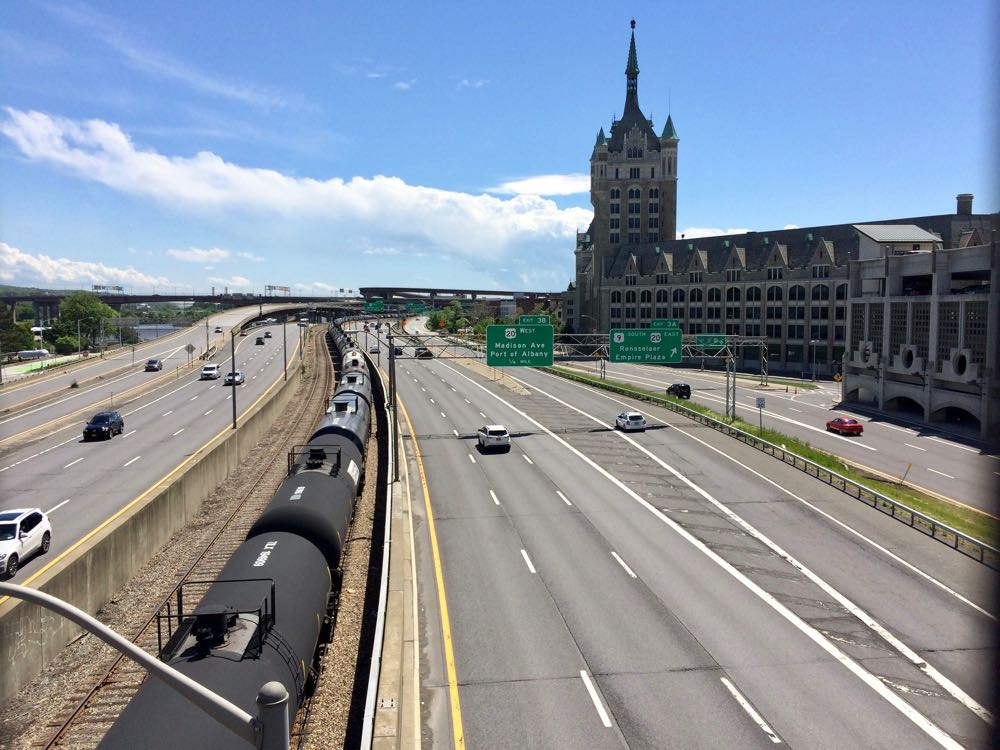
The formal process for thinking about the future of 787 -- the I-787/Hudson Waterfront Corridor Study -- has been in progress for years. And now it looks like there's a product.
There's a public meeting to discuss the study report March 13 at the Albany Public Library Washington Ave branch. Event blurbage:
Learn about the study findings, progressed and potential strategies, and provide your thoughts on the study's report. This public open house will exhibit informational boards, invite your input on the report, and provide a presentation about the study findings by the project team at 4:30 p.m. and 6:30 p.m. on Tuesday, March 13th. The content of each presentation will be the same.
The open house is from 4-7:30 pm in the auditorium toward the rear of the APL branch.
This report -- headed up by the Capital District Transportation Committee, in collaboration with the state Department of Transportation and the city of Albany -- is the culmination of a process that started in 2014 and has moved slower than originally expected.
A transit-centric map of the Capital Region

Here's a follow-up of sorts to yesterday's post about the Capital Region's relatively low levels of traffic congestion, commuting, and planning for how to get around in the future.
An org called the Center for Neighborhood Technology has an online app called AllTransit that maps access to transit and jobs for locations.* It also digests all those bits into scores so they can be compared.
Here's the profile for the city of Albany, which scored a 7.8 -- "Very good combination of trips per week and number of jobs accessible enabling many people to take transit to work." (For some comparison, Colonie scores a 4.4 and Bethlehem a 2.5.)
One of the things that's interesting about this tool is the way it sort of creates what we sort of think of as as a topographic map of access-to-transit around the area. There are a handful of really high points -- the hearts of Albany, Schenectady, and Troy primarily -- and things slope downward from there.
*We could have sworn we mentioned this tool before, but couldn't find it while rummaging through the archive. It's probably all the way in the back of the cabinet, unopened, with the expiration date on the jar past.
(Thanks, Jen!)
Earlier:
+ The Capital Region's transit arteries
+ The potential impact of bus rapid transit
+ A brief (alternate) history of the Capital Region's much-admired light rail system
Traffic problems, relatively speaking
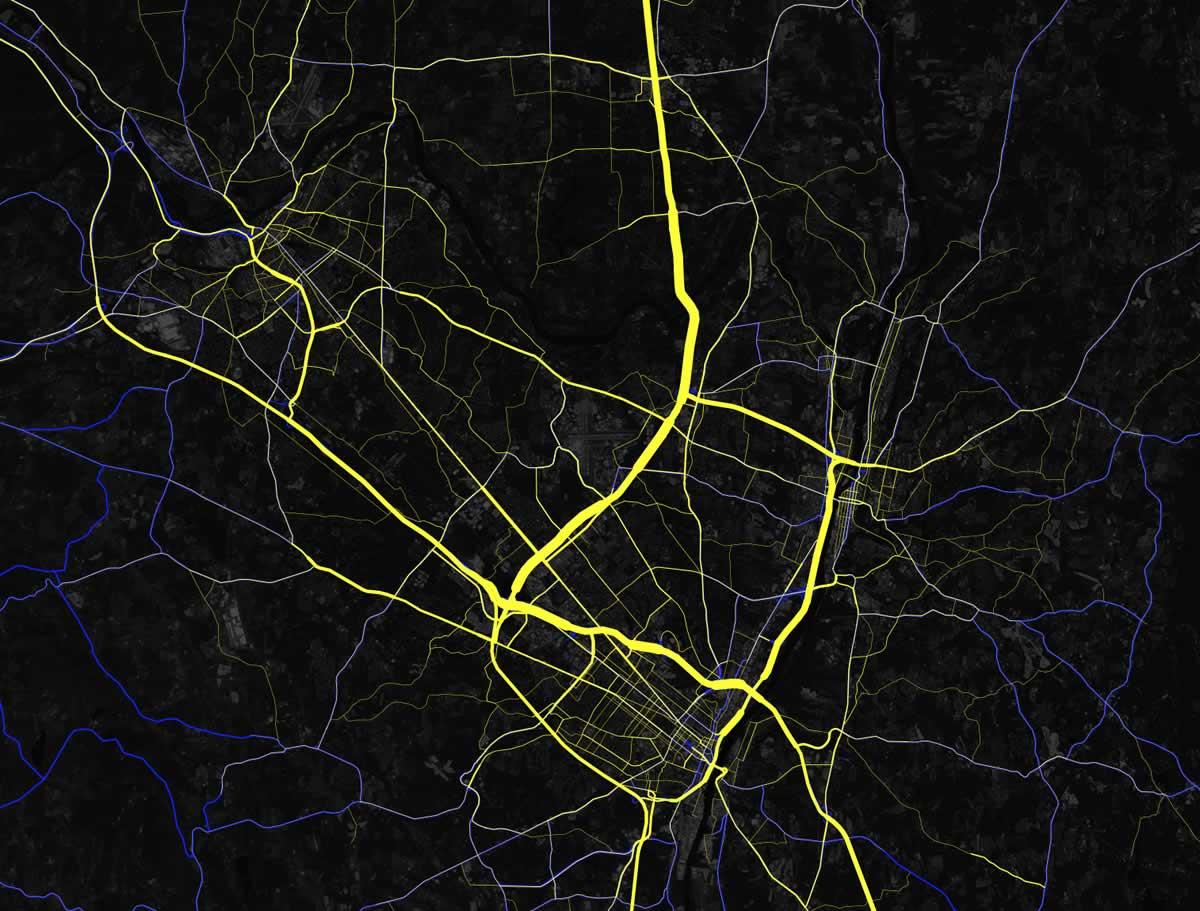
The Capital Region's traffic arteries, a clip from a national map created by Mapbox using data from the federal Highway Performance Monitoring System and OpenStreetMap.
Sometimes it's good to get a wider perspective on the sorts of things we all complain about.
Like traffic. From a national perspective, the Albany area doesn't really have traffic.
Albany ranked #118th in the United States for traffic congestion last year, according to the new global traffic scorecard from the transportation data consultancy INRIX (more about the report). Drivers in this area were estimated to spend just 4 percent of their driving time in congestion, 14 hours across the whole year.
In Los Angeles -- which topped the ranking for US cities and the world -- the total was 102 hours spent in congestion. And in New York City, ranked #2 in the US, the total was 91 hours.
Here are a few more things about that.
Capital Region economic development grants: sewer systems, The Palace, Cohoes Canal Square Park, Capital Roots, and more

Albany's plan to build a connector between the Mohawk Hudson Bike Hike Trail and the Helderberg-Hudson Rail Trail got funding.
The Capital Region scored $85 million in the state's annual Region Economic Development Council awards/game show porktacular on Wednesday. The region was a "top performer" for the second year in a row, and again landed the second-highest total of grants.
Here are details on the specific projects getting funding in the Capital Region are below, along with a bunch of that caught our eye. There are also region-by-region totals for the awards.
Capital Region rent, relatively speaking
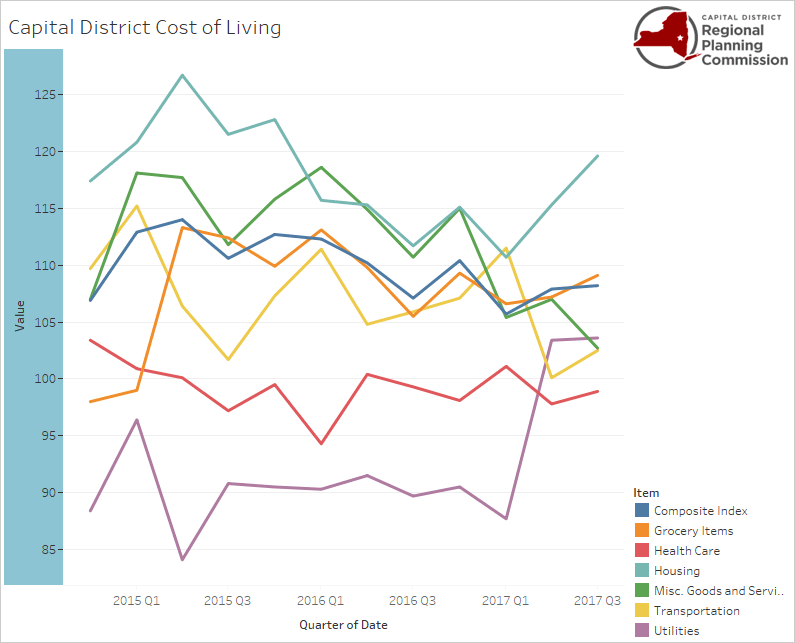
This graph is from the Capital District Regional Planning Commission and the Council for Community and Economic Research. It tracks a Capital Region cost of living measure relative to the national average quarter by quarter. That teal line running along the top is the cost of housing.
Speaking of residential develop and rents and related whatnot...
+ The median gross rent for Albany-Schenectady-Troy metro area was $931 (+/-21) in 2016, according the Census Bureau*. In the city of Albany it was $895 (+/-29). That is, half the rents (plus utilities if not included) were above that mark and half were below.
+ In 2007, the median gross rent for the Albany metro was $779 (+/-18) and for the city of Albany $746 (+/-37). The 2016 rent levels mentioned above are an increase of almost 20 percent in both cases. That increase outpaced general inflation for the United States -- if both had risen at the pace of general inflation, they would have been at $900 and $862.**
15 Albany-area mentions in The Onion, ranked
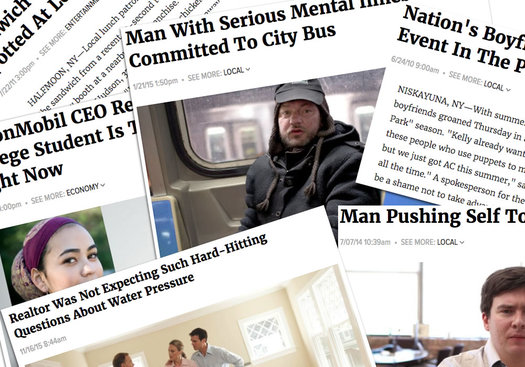
As noted earlier this week when The Onion savagely roasted the Capital Region's pitch for the Amazon headquarters, mentions of this area often pop up in the satirical outlet.
So here are 15 of those mentions, ranked by burn level.
A snapshot of the Capital Region pitch to Amazon
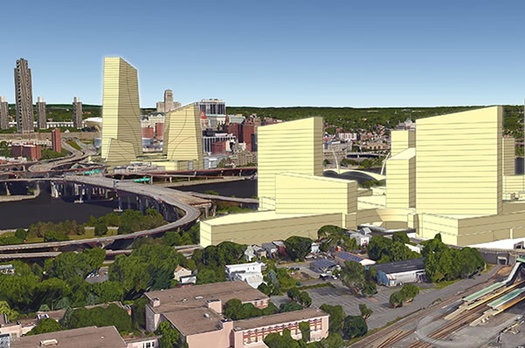
Today is the day that cities and metropolitan areas all around the country are offering themselves up to Lord Bezos as his empire looks to build an off-world colony beyond Amazon Prime in Seattle.
The Capital Region is one of those metros, and the Center for Economic Growth has posted an overview of its pitch. It centers on a a potentially massive new complex spanning the Hudson River at Albany and Rensselaer. A clip:
With Amazon specifying an interest in a downtown or urban location with a layout similar to its Seattle campus, CEG's centerpiece proposal is the Amazon Promenade. This downtown headquarters would straddle the iconic Hudson River, with a capacity for 2 million square feet of office space in the City of Albany's 25-acre site between the Times Union Center and Broadway and an additional capacity for 6 million square feet on 75 acres directly across the Hudson in the City of Rensselaer. The Albany and Rensselaer sites could be connected with a pedestrian bridge across the Hudson, water taxies and/or a gondola.
There are a handful of renderings -- and we've pulled them out for easy gawking. The online pitch also argues the region's case in terms of aspects such as education, housing affordability, natural disaster susceptibility, and crime.
The assimilation of the Capital Region by the Bezos is a low probability event -- this place is competing against pretty much every other relatively large metropolitan area in the US and Canada. That said, here are a few very quick thoughts...
Scanning the Capital Region Economic Development Council's 2017 priority projects
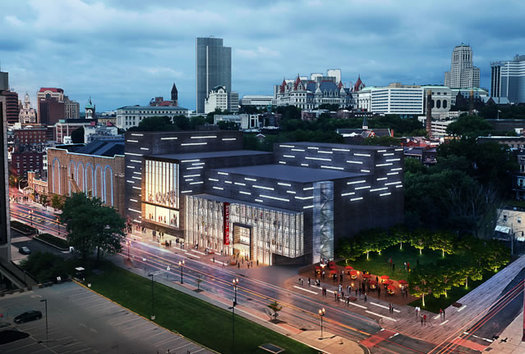
The proposed Palace expansion is back up for state money.
The Capital Region Regional Economic Development Council released its 2017 progress report this week. And one of the things that's immediately notable about these reports is the list of proposed priority projects up for state money in the next round of the Cuomo administration's Regional Economic Development Council initiative.
You know, these are the grants that are announced at an awards-show-like event, usually in December.
The list usually includes some interesting bits, and it also sometimes surfaces notable projects that are in the works.
So, let's have a look at a handful of items that caught our eye. They include mixed-use residential projects, the Schuyler Building renovation, the Capital Roots Grow Center, and -- for a second year -- the proposed Palace Theatre expansion...
Hello, 838
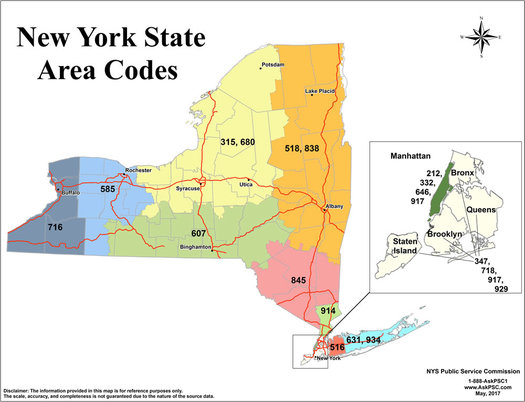
Starting today -- September 19 -- if you get a new phone number/line, it's possible it could be a number with the 838 area code.
As you know, the 518 area code was running of out of telephone numbers. So a new area code is being added to its geographic area as an "overlay" to provide a new supply of numbers. The 518 area code and the new area code, 838, will both exist in the same area. Everyone with a current 518 area code number gets to keep it. And now some new numbers -- and eventually all new numbers -- will be 838.
Aside from the new area code, the big change is that 10-digit dialing is now required for calling numbers within this area code. (That mandatory required started August 19.) That's probably not much of a hassle for many people now because so much dialing is via mobile phones or other digital systems. But if you have an older phone system, it's worth checking that it's adding the 518 to already existing numbers.
Also: Whenever you give out phone number here now, be sure include the area code.
For old-school dialing, or whatever
Not related really in anyway, but somehow seemed fitting to include here: The state's eBay store is currently selling a trio of wooden phone booths -- with pay phone -- for pickup in Schenectady.
... said KGB about Drawing: What's something that brought you joy this year?